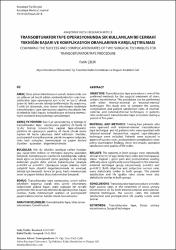Transobturator tape operasyonunda sık kullanılan iki cerrahi tekniğin başarı ve komplikasyon oranlarının karşılaştırılması
Özet
AMAÇ: Stres üriner inkontinansın cerrahi tedavisinde son on yılda en sık tercih edilen yöntemlerden biri olan transobturator tape operasyonu için ‘iç-dış’ ve ‘dış-iç’ olmak üzere iki farklı cerrahi tekniği tariflenmiştir. Bu araştırma, 5 yıllık bir dönemde, stres üriner inkontinans nedeniyle transobturator tape operasyonu yapılmış hastalarda her iki teknikle ilişkili başarı, komplikasyon ve hasta memnuniyet oranlarını karşılaştırmayı amaçlamıştır.
GEREÇ VE YÖNTEM: Son 5 yıl içerisinde ‘dış-iç’ tekniği ile transobturator tape operasyonu yapılmış 24 hasta ile ‘iç-dış’ tekniği tension-free vaginal tape-obturator yöntemi ile operasyon yapılmış 42 hasta olmak üzere toplam 66 hasta çalışmaya dahil edilmiştir. Hastalar, postoperatif komplikasyonlar, pelvik muayene bulguları, stres testi sonuçları, memnuniyet ve yaşam kalitesi ölçekleri açısından değerlendirilmiştir.
BULGULAR: Her iki teknikle ameliyat edilen hastalar yaş, vücut kitle indeksi ve menopoz durumu açısından benzerdi. Komplikasyon oranlarına bakıldığında, vajina/kasık ağrısı ve postoperatif işeme güçlüğü iç-dış tekniği kullanılan grupta daha yüksek bulunmuştur (sırasıyla p=0.043 ve p=0.001). Operasyon başarı oranları, hem subjektif hem objektif değerlendirmede iki ameliyat tekniği için benzerdi. Ayrıca iki grup, hasta memnuniyet oranı ve yaşam kalitesi skoru bakımından benzerdi.
SONUÇ: Transobturator tape operasyonu, tercih edilen teknikten bağımsız olarak stres üriner inkontinans tedavisinde yüksek başarı oranı sağlayan bir cerrahi yöntemdir. Her iki cerrahi teknikte de operasyonun başarı oranları, hasta memnuniyet oranları ve postoperatif yaşam kalitesi skorları benzer olarak bulunmuştur. OBJECTIVE: Transobturator tape procedure is one of the preferred methods for the surgical treatment of stress urinary incontinence. This procedure can be performed with either ‘internal-external’ or ‘external-internal’ techniques. This study aims to compare the success, complication and patient satisfaction rates of internal-external and external-internal techniques in patients who underwent transobturator tape procedure during a period of five years.
MATERIAL AND METHODS: Twenty-four patients who were operated with ‘external-internal’ transobturator tape technique and 42 patients who were operated with ‘internal-external’ tension-free vaginal tape-obturator technique were included. Patients were assessed in aspect of success rates, postoperative complication rates, pelvic examination findings, stress test results, operation satisfaction and quality of life scales.
RESULTS: The patients in both groups were statistically similar in terms of age, body mass index and menopausal status. Vaginal / groin pain and postoperative voiding difficulty were significantly more frequent in the internal-external technique group (respectively p=0.043 and p=0.001). Both objective and subjective success rates were statistically similar in both groups. The patient satisfaction and life quality rates scores were also statistically similar in both groups.
CONCLUSIONS: Transobturator tape procedure provides high success rates in the treatment of stress urinary incontinence. As for both internal-external and external-internal techniques, the success rates, the patient satisfaction and postoperative life quality scores were similar.
Kaynak
Afyon Kocatepe Üniversitesi, Kocatepe Tıp DergisiCilt
19Sayı
2Koleksiyonlar
- Makaleler [452]
- TR-Dizin İndeksli Yayınlar Koleksiyonu [241]



















